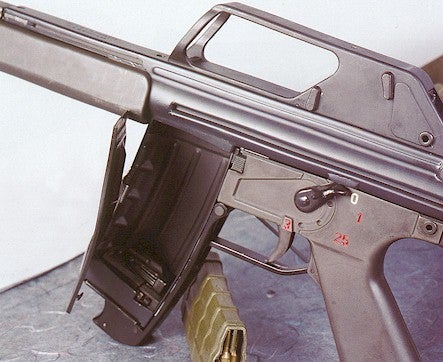Hognose tackles one of the most confusingly designated of all Heckler and Koch weapons, the HK36 (distinct from the G36) and its 4.6x36mm round (itself distinct from H&K’s 4.6x30mm PDW round):
Around 1970, Heckler & Koch was doing well, but their restless engineers were thinking: what’s next? One thing we learn from history is that no weapons system lasts forever, and there was maybe one more go-around in the company’s present line of roller-locked weapons, trading some militaries’ 7.62 NATO weapons for 5.56 NATO ones. But what could offer stingy weapons procurers enough reason to stop sitting on their wallets?
The company explored many ideas, in two major strains. One is now well-known: caseless ammunition with a radically new action and new modes of fire, which became the G11 through many, many series of tests and evaluations in the 1970s and 1980s. The second was, perhaps, meant as a technical backstop if the G11, a technical stretch, proved infeasible. It became the HK36 — not the G36, the technical backstop HK had to create after the G11 failed, but the very obscure G36. The rifle existed in, perhaps, three prototypes. It used a unique 4.6 x 36mm intermediate cartridge.
The Big Ideas: Weight and Spoonery
When we referred to this as the “other” 4.6, we’re referring, of course, to the fact that this is not 4.6 x 30 HK round used in the familiar (at least, in appearance) MP7 series widely used by US and foreign special operations forces. The 4.6 x 30 is the latest of HK’s many attempts to make an even smaller caliber round, but it was aimed at a different objective: the short-range SOF and LE submachine gun, making most shots inside 100 meters; it has very light bullets (31-40 grains for warshots) and is a hair over half the weight of 9×19 or 5.56×25 ammo, allowing a reduction in operator burden (or an increase in ammo load, naturally).
The 4.6 x 36 was developed in the 1960s to meet a different requirement entirely: that of a normal assault rifle intermediate cartridge, with engagement ranges mostly inside300 meters. Two ideas drove the 4.6 x 36: reducing ammunition and system weight for a given effect, arguably the longest-standing trend in firearms design, and increasing terminal effect in the intended target, to wit, enemy homo sapiens. The first objective drove the reduction in caliber and length. To get to acceptable lethality, higher chamber pressures (51,200 psi CUP) were accepted, but the light projectiles (42 grain hard core/54 grain softcore) didn’t reach outlandish velocities (2,600-2,800 fps). It required a fast barrel twist to stabilize the light projectiles; 1 turn in 6.3″ was selected. HK claimed the round shot flat, allowing it to print to point of aim from 0 to 300 meters without any need for range compensation by the shooter or the sight.
The “spoonery” of the subtitle refers to an invention of Dr Gunther Voss of CETME, which remained in symbiosis with HK itself at least at the time he applied for German and US patents in 1964 and 65 (his US Patent, 3,357,357, was granted in 1967).
“…to provide a rifle bullet wherein the tip of the bullet is of an asymmetric shape. When this bullet strikes the target, forces are generated which accelerate the bulet inclination.
It is stil another object of the present invention to provide a rifle bullet wherein the turning moment produced by the inclination accelerating forces increases and the bullet inclination is produced more rapidly when the distance between the bullet center of gravity and the bullet tip is greater. It is possible to increase the effect produced by the bullet tip asymmetry through the backward displacement of the bullet center of gravity.”
As Hognose himself would say, please do click through and Read The Whole Thing ™.
The HK36 is a truly weird firearm, with some prototypes representing the last en-bloc clip developments ever (the green plastic 25-round en-bloc of one being just visible in the title image). These were loaded through a door in the rifle’s fixed magazine body, after the follower was pulled down into the ready position by a lever connected to the follower via a chain:

The HK36 with the loading lever retracted, and an en-bloc clip inserted. Image source: Weaponsman.com
By the time the HK36 was designed, the Germans were no strangers to micro-caliber rounds. Before the 21st Century, there had been no less than seven German micro-caliber experiments; the seven known to me being in chronological order the 4.15×45 RFA, the 4.7×45 DAG, the 4.9×45 DAG, the 4.3×45 DAG, the 4×37 IWK, the 4.6×36 CETME/HK, and the 4.6×30 H&K PDW, which barely squeaks in the door with an introduction date of 1999. What made the 4.6×36 different was that, as the name indicates, it was a joint effort between the governmental bureau CETME of Spain and H&K of Germany. As a result, rounds are seen with either red or green primer sealant, the former indicating Spanish manufacture and the latter indicating German manufacture. This development began with the Spanish 4×27 CETME round, which was designed to minimize ammunition weight while maintaining “humanitarian” wounding characteristics – a design criterion that sounds downright funny to the post-Madrid world.
The micro-caliber concept eventually died with the end of the Cold War, but was resurrected as a result of the NATO PDW trials, which in typical Treaty Organization fashion produced no standard round. Today, rounds with caliber smaller than .22″ are decidedly unfashionable where standard infantry rifles are concerned, but the potential benefits of a smaller caliber – retention of ballistic characteristics and a dramatic reduction in weight – remain.
 Your Privacy Choices
Your Privacy Choices



